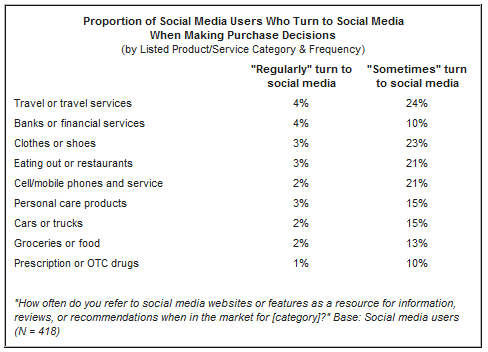
Im Sinne des Reputation Managements müssen Unternehmen heutzutage wissen, welcher ‘Buzz’ im Web über sie und den Mitbewerb geschrieben und diskutiert wird, sowie welche Informationen ausgetauscht werden.
Um hier den Anschluss nicht zu verpassen, gibt es zahlreiche Plattformen (siehe Bild), die das ‘Monitoring’ einer Person,eines Brands, von Produkte, des Mitbewerbs und der extrem dynamischen Social Media Welt ermöglichen. Marketing Pilgrim hat diese in zwei Post zusammengefasst. Hier die übersetzte Zusammenfassung in Kurzform…
Die bekanntesten Monitoring Tools
Amazon: Neu und gefragte Produkte via ‘tags’ beobachten und dann ähnlich ‘tags’ beobachten. Gut für Produkt-Management und Entwicklungsteams…
Blog Comments und Backtype: Die Kommentare auf Blogs zu verfolgen, ist schwierig und aufwendig. Auch wenn ein Post positiv ist, kommt er gerne auch mal als negative Nachricht rüber. Über diesen Service verfolgt man die kompletten Kommentare. (RSS-Feed!)
Blogpulse – Conversation and Trends: Links von und zu Blog Posts sowie Key-Word Tracking auf Blogs.
Delicious: Online Bookmark Service, der Bookmark-Sharing ermöglicht und zeigt, wenn jemand ein Bookmark setzt, welches ihre Firma beinhaltet -am Beispiel iPhone.
Digg und Reddit: News, die beliebt sind, machen hier das Rennen und wer den RSS-Feed eingestellt hat, folgt den Nachrichten über die eigene Firma.
Flickr: Mitarbeiter veröffentlicht ein ‘Top-Secret’ Produktfoto? Foto von Top Manager im Bordell? Wenn der Firmenname auftaucht oder der Name einer Person, zeigt der RSS-Feed das an.
Google News: Nennungen ihrer Firma im Main Stream Media Konzept. Firma eingeben, sortieren der Ergebnisse nach Datum und dann RSS Fed aktivieren.
Google Blog Search: Die Bloggosphäre ist aktiv und Google Blog Search bildet meistens alles ab, was in der Social Media Welt ‘pingt’. (RSS-Feed!)
Google Patent Search: der Name ist Programm – wer seine Patente schützen und den Mitbewerb beobachten will.
Google Alerts: Kein RSS Reader-Liebhaber? OK, dann eben per Email alle Informationen rund um Firma, Produkte, etc. tracken und in die Mailbox bekommen.
Google Trends, Trendrr und Trackur (letzterer kostenpflichtig): Was sind die meist gesuchten Keywords? Sogar auf Länder und Städte eingrenzbar…
Technorati und Brand Mentions: Alles,was sich in der Social Media Welt und Bloggosphäre abspielt, lässt sich hier schnell finden – auch, wer Backlinks setzt…
Twitter: Wer die Suchmaschine von Twitter nutzt, kann sein Brand, Produkte, den Mitbewerb usw. bei seinen Twitteraktivitäten im Auge behalten. Für die RSS-Hasser gibt es alternativ TweetBeep.
Wikipedia: die glaubwürdigste Wissensadresse im Web. Was wird an ihrem Profil verändert oder jemand versucht, zu ihnen führende Links zu entfernen? Der RSS Feeds meldet sich…
Yahoo News and Moreover News: Schneller Firmen-, Mitbewerbs- und Branchen-Nachrichtenüberblick mit RSS-Feed Modell.
YouTube und MetaCafe: siehe Flickr auf der ‘Videoebene’… – am Beispiel ASUS
Weitere nützliche Monitoring-Tools
Boardtracker: Blogs spiegeln nicht immer die hochwertige und hintergründige Kommunikation – Foren und Message Boards schon eher. Wenn ihre Firm ain einem Thread genannt wird, kommt die Nachricht per RSS.
Compete: Suchanalyse hinsichtlich von Keywords – auch um den Mitbewerber und seine Strategie auszumachen.
Edgar Online: Wie steht es finanziell um den Mitbewerb (eher USA)?
Facebook Lexicon: Auf dem derzeit angesagtesten Social Network können Sie checken, welche Key Words auf Facebook verstärkt genutzt werden. Keotag: Wer nutzt welches Tag. Cool ist es vor allem, wenn man Firmen findet, die ihre Firma und ihre Produkte taggen – oder gleich zahlreiche Firmen sieht, die die gleichen Tags nutzen.
my ON-ID: Für das Business entscheidend, ist ihr guter Ruf hinsichtlich ihrer persönlichen daten im Netz, den die Plattform regelmäßig ‘monitored’ – mit dem netten Nebeneffekt des Eigenmarketings.
oodle: Falls der Mitbewerb an die Mitarbeiter will, findet man hier die Stellen der Personen auf die man selbst besonders achten muss.
Seeking Alpha: Der ‘Lauschangriff’ via Conference Call Transkripten bei Aktiengesellschaften…
upcoming.org: Hinsichtlich Veranstaltungen auf dem Laufendem bleiben. Beispiel: web strategy
User Name Check: Auch wenn man nicht weiß, was man damit tun, aber den Usernamen sollten man haben.
Spot On!
(Fast) alle Monitoring-Tools sind kostenfrei! Welche für das eigene Business sinnvoll sind, muss jeder selbst entscheiden. Auffällig ist, was man mit Google alles machen kann (und was Google damit alles monitort)…
 Although web 2.0 provides all the benfit for e-learning, the use is till low. The study “Benchmarking Online Operations: Snapshots of an Emerging Industry” by the consulting company Eduventures shows that the education they offer is still based on “rudimentary, text-based technology”. This stands in contrast to webinars, web-conference or any kind of podcast or vidcast tools that the web 2.0 world offers today. “But when it came to technology, the Eduventures survey found that the widely used tools are e-mail, text discussions that don’t happen in real time, physical textbooks, and word and PDF documents”, reports http://chronicle.com/blogPost/Online-Programs-Profits-Are/8517/?sid=wc&utm_source=wc&utm_medium=en.
Although web 2.0 provides all the benfit for e-learning, the use is till low. The study “Benchmarking Online Operations: Snapshots of an Emerging Industry” by the consulting company Eduventures shows that the education they offer is still based on “rudimentary, text-based technology”. This stands in contrast to webinars, web-conference or any kind of podcast or vidcast tools that the web 2.0 world offers today. “But when it came to technology, the Eduventures survey found that the widely used tools are e-mail, text discussions that don’t happen in real time, physical textbooks, and word and PDF documents”, reports http://chronicle.com/blogPost/Online-Programs-Profits-Are/8517/?sid=wc&utm_source=wc&utm_medium=en.








